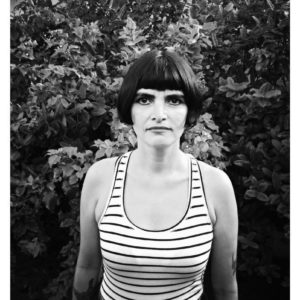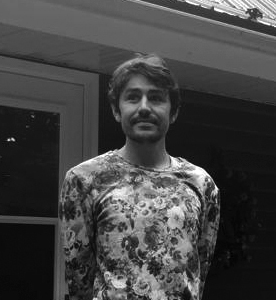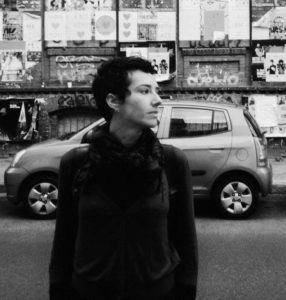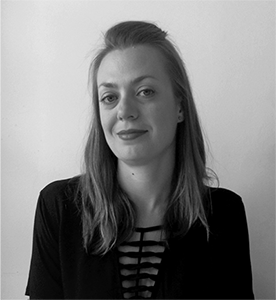
Ane Rodríguez Armendariz traz ao júri do projeto Kaá sua larga experiência em instituições culturais espanholas. Formada em Jornalismo, foi nomeada Diretora Cultural de Tabakalera, em San Sebastián, na Espanha, para estabelecer o projeto cultural na antiga fábrica de tabaco que reabriu como o Centro Internacional para a Cultura Contemporânea em setembro de 2015. Sua experiência em instituições inclui a ARCO – Feira de Arte Contemporânea em Madrid (na qual foi responsável por programas de curadoria e galerias internacionais), o Museu de Arte Contemporânea de Castilla y León (MUSAC, onde foi coordenadora geral do museu em 2010), e Matadero Madrid, como parte da equipe de programação (2011-2012).Também fez parte da equipe Bienal Manifesta 5 em San Sebastian e foi colaboradora do Festival de Cinema de San Sebastian.
Ane Rodríguez Armendariz brings to Kaá’s jury her extensive experience in Spanish cultural institutions. Graduated in Journalism, she was appointed Cultural Director of Tabakalera to set up the cultural project at the former Tobacco factory that reopened reconverted into an International Center for Contemporary Culture in September 2015 in San Sebastian, Spain. Her experiencein Spanish art institutions includes the contemporary art fair in Madrid, ARCO, where she was in charge of curated programmes and international galleries; MUSAC, the museum of contemporary art of Castilla y León, where she was the general coordinator of the museum (2010), and Matadero Madrid, as part of the programming team (2011-2012). She was part of the Manifesta 5 Biennial team in San Sebastian and has also been a contributor at the San Sebastian Film Festival.

Maria Isabel Rueda atualmente gerencia e trabalha como curadora artística no La Usurpadora, em Puerto Colombia. Ela também é editora da revista independente Tropical Goth. Rueda é bacharel e mestre pela Universidade Nacional da Colômbia e lecionou na Universidade Nacional e na Universidade Jorge Tadeo Lozano, em Bogotá, e na Faculdade La Salle, em Barranquilla. Foi co-curadora de espaços independentes como El Bodegón e La Residencia, em Bogotá. Ao longo de mais devinte anos, Rueda criou um corpo singular de trabalhos que entrelaça o Góticocom o Tropical. Nas obras de Rueda, o gótico se refere a imagens preto e brancoaltamente estilizadas e melancólicas que, quando introduzidas no ambientetropical, aparecem como absurdas, transportando o chiaroscuroromântico de suas fontessetentrionais e enquadrando-o em um contexto geográfico completamentediferente. A forma com a qual Rueda conceitua “Tropical Gothic” continuamenteressoa com essas duas sensibilidades distintas, atraindo o espectador para alémdo puramente material e pragmático; entender como os rios, as plantas, os fios,os tecidos e a coca estão todos imbuídos de sua própria força espiritual, mesmoque essa força pareça estar além do que muitos hoje parecem capazes deentender.Rueda passou a maior parte de seus anos deformação nas cidades. Hoje ela vive no litoral e, através de seu trabalhocuratorial, esforça-se para manter uma conexão profunda com o ambiente a fim denão perder a capacidade de se comunicar com pessoas que veem o mundo de forma diferentedo que é agora convencional.
Maria Isabel Rueda currently manages and works as artistic curator at La Usurpadora in Puerto Colombia. She is also the editor of the independent magazine, Tropical Goth. She holds aBFA and MFA from National University of Colombia. She has taught at National University, Jorge Tadeo Lozano University in Bogotá and La Salle College in Barranquilla. She was co-curator of independent venues like El Bodegón and La Residencia in Bogotá. Over more than twenty years, Rueda has created a singular body of work that intertwines the Gothic with the tropical. In Rueda´s works, the Gothic refers to highly stylized and melancholy black and white imagery, which, when introduced into the tropical environment, appears as absurd, thus transporting romantic chiaroscuro from its Northern sources and framing it within a completely different geographical context. Ultimately, Rueda´s conceptualization of “Tropical Gothic” continually resonates with these two distinct sensibilities, compelling the viewer beyond the purely material and pragmatic; to understand how the rivers, plants, threads, textiles, mochilas and coca-as well as the underlying mournful weeping-are all imbuedwith their own spiritual force, even if this force seems to lie beyond what many today seem capable of understanding. Rueda spent much of her formative years in cities. Today she lives by the sea, and through her curatorial work she strives to maintain a deep connection to her environment, to not lose the capacity to communicate with people who see the world very differently from what is now conventional.

O suíço Richard Le Quellec participa do júri do programa Kaá e traz em sua bagagem diversas experiências em espaços e iniciativas que promovem desenvolvimento cultural e social a partir de situações de troca, redes e compartilhamento. Le Quellec é artista visual e desenvolvedor cultural formado pela Universidade de Arte e Design de Genebra. Desde 2007, é motivado pela influência de práticas culturais no desenvolvimento social e político da cidade. Consequentemente, seus envolvimentos geraram espaços de projetos e eventos de longo e curto prazo. Le Quellec foi membro da Union of Self-managed Cultural Spaces (UECA) de 2007 a 2011 e membro do Committee of Artists and Cultural Developers (RAAC). É fundador e coorganizador da The Biennale des espaces d’arts indépendants e fundador da cooperativa cultural Ressources Urbaines. Com sede em Genebra, na Suíça, ele é o gerente de projetos da The Embassy of Foreign Artists (EoFA), local onde artistas moram, trabalham, conduzem pesquisas e compartilham ideias.
Swiss Richard Le Quellec joins the Kaá’s jury and brings his experiences indifferent spaces and initiatives that promote cultural and social developmentfrom exchange, networking and sharing situations. Le Quellec is a visual artistand cultural developer with a degree at Geneva University of Art and Design(HEAD) in 2005. Since 2007, he is motivated by the influence of culturalpractices on the social and political development of the city. Consequently,his involvement has generated both long and short-term project spaces andevents. Richard was a member of the Union of Self-managed Cultural Spaces(UECA) from 2007 to 2011, and a member of the Committee of Artists and CulturalDevelopers (RAAC). He’s founder and co-organizer of The Biennale des espacesd’arts indépendants, and founder of the cultural cooperative RessourcesUrbaines. Based in Geneva, Switzerland, he is the project manager of TheEmbassy of Foreign Artists (EoFA), a place for artists to live, work, conductresearch, and share ideas.

Michelle Sommer integra o júri do programa Kaá e traz à comissão sua experiência no ensino,pesquisa, crítica e curadoria em artes visuais. É pós-doutoranda em Linguagens Visuais na Escola de Belas Artes da Universidade Federal do Rio de Janeiro,doutora em História, Teoria e Crítica de Artes pela Universidade Federal do Rio Grande do Sul com estágio doutoral junto à University of the Arts London /Central Saint Martins / na área de estudos expositivos. É mestre em Planejamento Urbano e Regional e arquiteta e urbanista. Em 2017 foi co-curadorada exposição ‘Mário Pedrosa: de la naturaleza afectiva de la forma’ no Museu Reina Sofia, em Madri, que obteve o prêmio destaque pela curadoria da exposição pela ABCA – Associação Brasileira de Crítica de Arte em 2018. É autora de diversos livros e contribui regularmente para publicações nacionais e internacionais e projetos de artes visuais em formatos diversos.
Michelle Sommer joins Kaá’s jury and brings to the committee her experience in teaching, research, criticism and curatorial projects in visual arts. She is a postdoctoral researcher in Visual Languages at School of Fine Arts at the Federal University of Rio de Janeiro, PhD in History, Theory and Criticism of Arts at the Federal University of Rio Grande do Sul, with PhD internship at the University of the Arts London, Central Saint Martins, in Exhibitions Studies. She is an architect and holds a master degree in Urban and Regional Planning. In 2017 she was co-curator of the exhibition ‘Mário Pedrosa: de la naturaleza afectiva de la forma’ at the Reina Sofia Museum in Madrid, which won the prize for Curatorship by the ABCA – Brazilian Association of Art Critics in 2018. Author of several books, she contributes regularly to national and international publications and visual arts projects in various formats.

Professora e pesquisadora do Instituto de Artes da UFRGS, Bruna Fetter é Doutora em História, Teoria e Crítica de Arte (PPGAV/UFRGS). Foi pesquisadora visitante na New York University (2014/2015), possibilitado por bolsa Fulbright. Curadora de diversas mostra, entre 2006 e 2007 coordenou a equipe de produção executiva da 6a Bienal do Mercosul. É membro da Associação Nacional de Pesquisadores em Artes Plásticas, da Associação Brasileira de Críticos de Arte e da Associação Internacional de Críticos de Arte. Coautora do livro “As novas regras do jogo: sistema da arte no Brasil” (Editora Zouk, 2014), colaborou nas publicações “Artes visuais – ensaios brasileiros contemporâneos” (org. Fernando Cocchiarale, André Severo e Marília Panitz, FUNARTE, 2017), “Práticas contemporâneas do mover-se” (org. Michelle Sommer, Circuito, 2015) e “A palavra está com elas: diálogos sobre a inserção da mulher nas artes visuais” (org. Lilian Maus, Panorama Crítico, 2014).
Professor and researcher at the Art Institute at UFRGS, Bruna Fetter holds a PhD in ArtHistory, Theory and Criticism (PPGAV/UFRGS). She was a Fulbright VisitingResearcher at New York University (2014/2015) as part of her PhD research. Shecurated several shows and, between 2006 and 2007, coordinated the executiveproduction team of the 6th Mercosur Biennial. She is a member of ANPAP(Brazilian Association of Visual Arts Researchers), ABCA (Brazilian Associationof Art Critics) and AICA (International Association of Art Critics). She is aco-author of the book “The new rules of the game: the art system inBrazil”, published in 2014 by Zouk. She also collaborated in thepublications “Visual arts – Brazilian contemporary essays” (org.Fernando Cocchiarale, André Severo and Marília Panitz, FUNARTE, 2017),”Contemporary practices of moving” (org. Michelle Sommer, Circuito,2015) and “The ladies have the floor: dialogues on the insertion of womenin the visual arts” (org. Lilian Maus, Panorama Crítico,2014).
